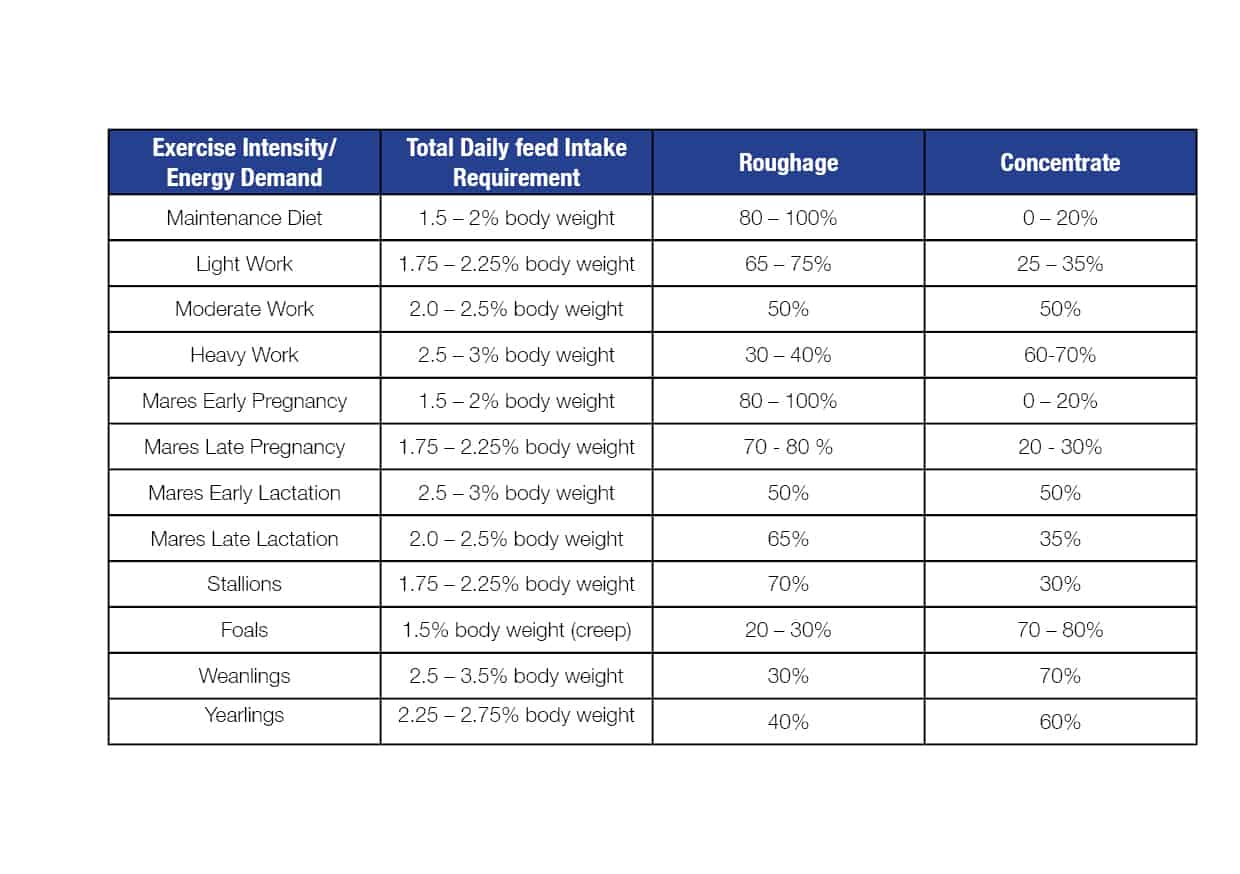How to choose the best feeding regime for your horse
A horse’s nutritional needs are influenced by several factors. Factors such as weight, age, exercise intensity, training stage and reproductive demands all require consideration when determining the best feeding regime for your horse. Horses require an adequate and balanced diet with enough feed to satisfy their hunger and occupy their time eating, as well as regular daily exercise or opportunity for free exercise each day.
Horses should be fed on a body weight basis relative to their specific needs. Roughage, such as hay, chaff or pasture, must form the foundation as the fiber source of all diets at a strict minimum of 1kg/100kg body weight for all horses, with concentrates added in proportion to workload (Harris et al, 2005). Horses in training, or those kept in stables, require a blend of hay and concentrate to supply the major nutrients required in an adequate bulk that they can consume. An adequate supply of fresh, clean water must always be available.
The below table outlines the required feeding regime for different workloads and the recommended roughage to concentrate ratio:

When a horse’s exercise intensity and duration increase, the horse’s energy and therefore nutritional requirements also increase. The addition of concentrates (e.g. grains and supplements) containing a higher energy content enables these energy requirements to be met. It must be considered that the horse has evolved to digest roughage efficiently and consequently, in order to, maintain gastrointestinal health, motility and minimise digestive dysfunction, roughage content must be supplied to adequate levels. The below breakdown can be used to determine your horses work intensity (Frape, 1986):
- Light Work: 1- 3 hours of work per week; 40% walk, 50% trot, 10% canter. Light work includes recreational riding, beginning of training programs and the occasional show horse.
- Moderate Work: 3 – 5 hours per week; 30% walk, 55% trot, 10% canter, 5% low jumping, cutting or other skill work. Moderate work includes school horses, recreational riding, beginning of training/breaking, show horses, polo horses and stock work
- Heavy Work: 4 -5 hours per week: 20% walk, 50% trot, 15% canter, 15% gallop, jumping or other skill work. Heavy work includes stock horses, polo horses, eventing horses.
- Very Heavy Work: 6 – 12 hours per week. Very heavy work includes racing and elite 3-day event horses.
Horses are non-ruminant herbivores and have evolved to graze continuously on fibrous plant material, for as much as 18-20 hours per day. They are graziers or trickle feeders, the feed they ingest (bolus) together with saliva from chewing, pass into the stomach in a constant, small trickle (Frape, 1986). The horses stomach has a limited capacity of 9 – 15 liters and comprises just 10% of the digestive system. The stomach uses both acid and enzymes to start digestion and this works far more efficiently if your horse’s meal size is kept small.
The horse’s digestive system has evolved to digest starch and sugars in the small intestine rather than being fermented in the hindgut. Small frequent meals support this, leaving the fibrous fraction of the meal to be fermented in the same way that the fiber in grass or hay is (Frape, 1986). Splitting up your horse’s daily ration into 3-4 meals per day is ideal. If this is not feasible however, and only 2 meals per day are manageable, providing ad lib access to pasture or hay is recommended and utilizing a slow feeder to reduce your horse eating too quickly.
When formulating your horses ration, factors such as exercise intensity, weight, age and reproductive requirements all need to be taken into consideration. Ranvet Nutritionists can assess your diet and ensure it is balanced correctly. If you would like your horse’s diet analyzed by one of Ranvet’s Nutritionists please complete our Diet Evaluation form here: https://www.ranvet.com.au/nutrition-centre/diet-evaluation/.
References
Harris, P.A. and Arkell, K. (2005) How Understanding the Digestive Process can help Minimise Digestive Disturbances Due to Diet and Feeding Management. In: Equine Nutrition for All, 1st BEVA & Waltham Nutrition Symposia, pp. 9-14.
Frape, D.L. (1986) Equine Nutrition and Feeding. Longman Scientific and Technical, Essex, UK.
Experts in Equine Nutrition
Every product in the Ranvet range has been developed to meet a horse’s most specific need at any given time, be it in a training environment or on a breeding farm. Having pioneered the formulation of specific medications and dietary supplements for horses, the company is now recognised as a leader in the areas of equine health and nutrition.
